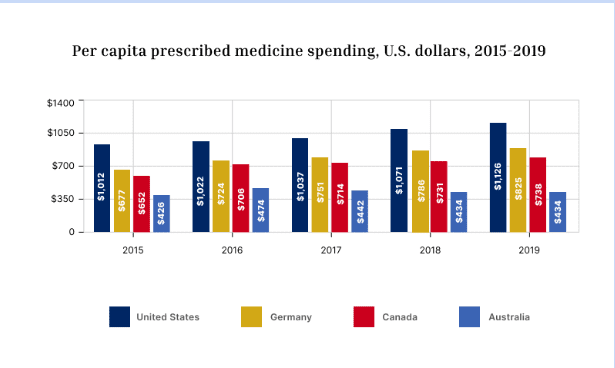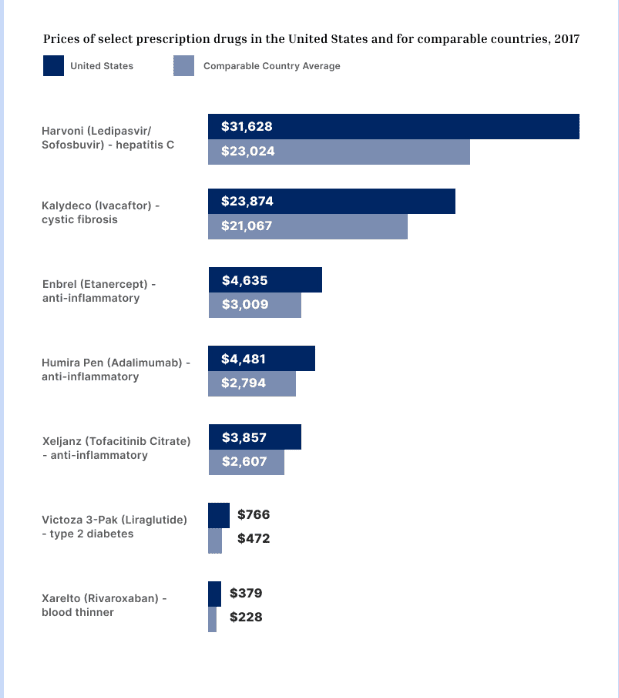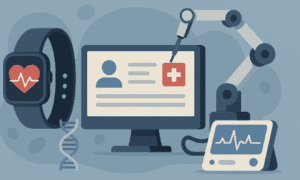The average U.S. citizen spends a tremendous amount on healthcare annually. In 2021, America’s healthcare spending was $4.3 trillion, which averages to around $12,914 per capita. Researchers expect the same to reach $6.8 trillion by 2030.
This out-of-pocket healthcare hurts everything, from the economy of the country to an individual’s mental health. A significant surge in premium costs, prescription drug prices, and high deductibles make healthcare expensive.
Nowadays, all it takes is one big medical bill to send a patient into financial debt. But the real question is: what’s causing these spikes in the first place?
In this blog, let’s try to understand what makes healthcare in the U.S. so expensive and explore how it impacts the current situation.
FACTORS CONTRIBUTING TO EXPENSIVE HEALTHCARE
Prescription drugs costs
Prescribed medicines and drugs are considerably more expensive in the U.S. compared to other nations. The lack of government regulations gives pharmaceutical companies the power to charge higher prices.
Moreover, most pharmaceutical companies nowadays deal directly with patients, increasing demand for specific drugs. This further drives up the cost.
Chronic diseases
Today, chronic diseases affect more than half of the U.S. population. CVDs, diabetes, cancer, and many more, contribute immensely to healthcare costs in the U.S.
A patient suffering from such conditions requires long-term treatment and medical intervention. It can be regular hospital visits, long-term medications, or specialized care. The total cost of managing these chronic illnesses is staggering.
Individual lifestyle
Your lifestyle choices play a significant role in determining your insurance premium.
For example, unhealthy lifestyles like eating junk, consuming alcohol, smoking, and a lack of exercise can make you more vulnerable to illnesses. These lifestyle choices can lead to chronic conditions and increase the need for costly treatments and medical interventions.
Poor diets and sedentary lifestyles contribute to the rise of obesity, diabetes, and cardiovascular diseases, which require expensive treatments and long-term care.
U.S. healthcare is highly fragmented
The U.S. healthcare system is extremely complex. It involves various stakeholders and insurance players, like private insurance, employer-sponsored plans, and government programs. Every system functions using a different set of rules and regulations, leading to administrative complications and increased costs.
Furthermore, this fragmentation leads to significant variation in quality and pricing. The cost of the same treatment can vary widely across various regions, hospitals, and insurance plans. The lack of price transparency makes it difficult for individuals to compare prices and make informed decisions.
Absence of government regulations
The U.S. healthcare system depends heavily on market influences and lacks centralized or government regulations. Without strict price laws, healthcare providers take advantage of setting service costs at their discretion.
This leads to a significant increase in costs for medical treatments, prescription drugs, and healthcare services. As a result, patients and insurance companies bear the burden of massive healthcare costs.
COMMON COSTS IN THE U.S. COMPARED TO OTHER DEVELOPED NATIONS
How does the expensive healthcare in the U.S. affect the cost of medical treatments? All prices listed below are from the most recent study by the International Federation of Health Plans, conducted in 2017.
- Consider the cost of an MRI scan, a commonly used medical procedure in the hospital. In the U.S., the average cost of an MRI was around $1,500 in 2017. In New Zealand, it was $750, whereas, in Holland, the price was as low as $190.
- Similarly, the average cost of angioplasty surgery, a procedure used to open blocked blood vessels, was $32,000 in the U.S. Meanwhile, in Switzerland, popular for its high-end healthcare standards and high cost of living, it was only $7,400.
- The average cost of hip replacement surgery in the U.S. was around $30,700, about $10,000 more than in Australia. The results for knee replacement surgery were almost the same.
- Prescription drugs also followed a similar trend. In 2019, the average amount of money spent on prescription drugs by each individual was $1,126. This amount was lesser compared to other nations, i.e., $552 per capita. It included $466 in healthcare plans and $88 in individual out-of-pocket expenses.

- The cost of prescription drugs to treat CVDs, Type 1 & 2 diabetes, and cystic fibrosis was way higher in the U.S. than in the Netherlands, Germany, or the U.K. For example, the cost of Humira in the United States was 423% more expensive than in the United Kingdom and 186% more expensive than in Germany.
These prices can vary depending on several factors. It includes benchmarking of prescription drug prices, the number and types of payers, the share of pharmaceutical companies, patents, the availability of alternatives, and more.

HOW CAN YOU MANAGE THE HEALTHCARE EXPENSES?
No individual or organization can fix all the instabilities present in the current healthcare system independently. We need to work together. We require individuals who need healthcare and those who provide the care to come together and play their roles.
Save money on prescription drugs
There are a few ways you can save money on prescription drugs:
- Explore generic or cost-effective alternatives instead of brand-name medicines (whenever possible). Make sure you ask your healthcare provider before buying them.
- Ask your healthcare provider about any prescription discount programs.
- Consider ordering your prescription drugs through the mail.
- Take all your medicines as directed by your provider. Not taking them can lead to further health problems.
Look for outpatient facilities
If you need surgery, ask your doctor about having it done at an outpatient clinic. These clinics are more cost-effective than hospitals.
Healthy lifestyle and preventative care
Preventative care measures like vaccinations, regular check-ups, and screenings help you avoid expensive treatments down the line.
Adopting a healthy lifestyle is vital. As mentioned above, incorporating healthy habits into your routine, such as eating nutritious food, exercising, and stress management, can minimize the risk of health problems.
Choosing a flexible payment plan
Flexible healthcare payment plans play a significant role in managing costly healthcare in the U.S. These plans allow patients to get the care they need in the most convenient and manageable way. It’s a win-win for healthcare providers as well as patients.
Take the example of Denefits. It allows individuals to break down the cost of their treatment into smaller, manageable monthly installments. Unlike many private lenders, Denefits has a NO CREDIT CHECK policy. It means you will still get approval even if you have a rocky credit history. This exclusivity makes healthcare more accessible to a wider range of patients.
Moreover, Denefits offers healthcare providers the opportunity to increase patient access, streamline payment processing, and enhance cash flow. Healthcare givers can provide more customizable payment plans that fit their patients’ budgets and needs. All this leads to increased revenue and strong customer relationships.
ENDNOTE
The high cost of healthcare in the U.S. is not a new thing. In most developed nations, the government plays a crucial role in negotiating prices and controlling costs. Unlike the U.S., the healthcare system in these countries doesn’t revolve around high administrative costs and overhead charges. However, a solution exists.
The healthcare system in America needs to identify the problems, find their root causes, and plan improvements accordingly. But identifying the problem is only half the battle. We, as responsible consumers, payers, or healthcare providers, need to work towards a more efficient and transparent healthcare system while ensuring optimal outcomes.



































